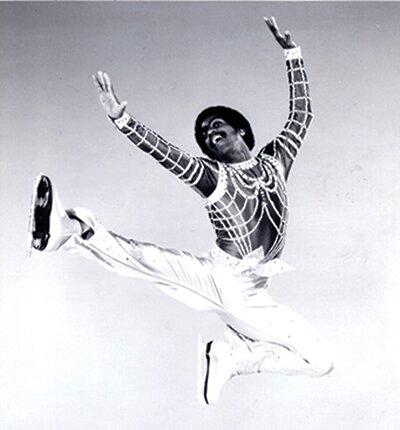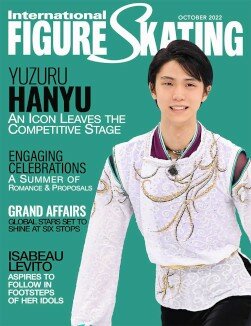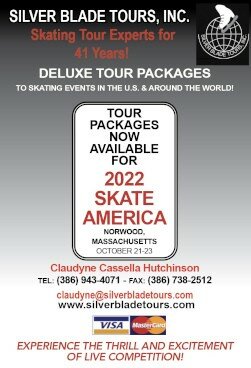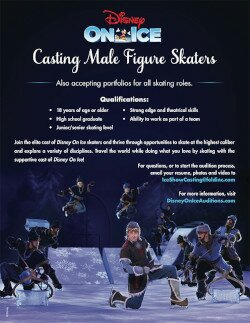

In December 2008, former World pairs champion Tai Babilonia wrote the first of a two-part series, ″In Living Color,″ for International Figure Skating magazine. The two articles capture the struggles and hurdles these pioneers of color had to endure and overcome in the sport of figure skating.
Atoy Wilson, Richard Ewell and Michelle McCladdie were the pioneers of color.
in skating. In 1966, Atoy Wilson broke the race barrier when he became the first African-American to win a U.S. title by claiming the U.S. novice crown. In 1970 Richard Ewell won the U.S. junior championships, and in 1972 he his partner, Michelle McCladdie, claimed the junior pairs title.
These three legends are rarely mentioned and have never been acknowledged for their accomplishments. I know what effect they had on me as a young skater, and now I want them to share their skating experiences and memories with you, along with their thoughts on the legendary coach Mabel Fairbanks.
Fairbanks is credited with being the first recognized skater of color who opened the door for all those who came after her. As a coach, she accepted students of all colors and all ethnicities, children of the wealthy and the poor, those who had the potential of becoming champions and those who did not. She gave everyone her best and treated everyone equally and with respect. Although she was never a champion, she helped create great champions.
So, when you read about Wilson, Ewell, McCladdie and so many others, you are also reading about Fairbanks.
How did you gravitate towards figure skating?
I was interested in gymnastics when I was 8 years old. I took tumbling and acrobatic classes on Saturday mornings. Somehow my parents decided to take me and my cousins to see an ice show. It happened to be Ice Follies, which appeared at that time at the Pan-Pacific Auditorium in Los Angeles.
Seeing the fine skaters glide across the ice in fancy outfits, their displays of jumps and spins, and the roar of the crowd watching the antics of ice comedian Mr. Frick was fun. But I was riveted to the talents of a young skater, Janet Champion. She was a child phenom who incorporated into her skating routines gymnastic and acrobatic moves, walkovers, handstands, backflips and great spins.
Her skating made a lasting impression on me. I was learning exactly the things I saw that night in those Saturday morning classes except it happened on the ice. I’m sure I begged and pleaded with my parents to take me skating. They found out that there was a rink in Hollywood, the Polar Palace. In my mind, at the age of 7 or 8, all I thought was that it looked so easy as the skaters performed on ice. I was in for a big surprise when I realized after one attempt around the rink that ice skating was going to be a bit more difficult than planned. But it was fun from day one.
What are your memories of the famous Polar Palace Ice Arena in Hollywood?
It was a cavernous wood-framed 200 by 100 cold ice rink. It always had the old ice rink aroma of ammonia, the fog that you don’t sense anymore in the newer rinks. On humid days, the ceiling would drip condensation, which would form small yellow ice cones on your patch. For me the most immediate memory is the “ice pit.” Polar did not have a Zamboni, but it resurfaced the ice with a small tractor, which pulled a scraper and leveler.
The discarded snow was pushed into this pit at the south end of the rink where ice attendants hosed the pit with hot water. For a kid when the pit door was open, it looked like you could fall into an immense deep abyss never to be seen again if you slid in. I made really sure that I did not falter when skating near that pit. This skating relic was truly the best in the west to learn skating.
What was your reaction, when you were introduced to your first coach, Mabel Fairbanks?
Love at first sight! I remember a bright smile, a soft and reassuring voice, a glint in the eyes, a strong hand and most of all the most exotic perfume I had ever smelled. The image was quite intoxicating. Immediately I felt safe and protected with her, yet I knew who was the boss and in complete control of my every move on the ice.
When you were accepted into the Los Angeles Figure Skating Club at the early age of 13 or 14, did you realize that you were a pioneer breaking the color barrier?
At that age no, not at all. I was consumed with being a good skater and enjoying the process of learning to jump well, spin well and etch out good figures.
I do remember that it felt awkward competing as an individual member of the USFSA (United States Figure Skating Association, now called U.S. Figure Skating), or having to be invited to skate in a club session. Then I felt as if I was an outsider or someone who didn’t belong. I envied those who were members of the club. Of course I wanted to be like them, and wear the club patch on my sweater and have my name announced, “Representing the Los Angeles Figure Skating Club.”
It was not until much later when I was older did I realize the importance of this barrier being broken and what Mabel and my mom must have gone through to get the opportunity for me – and others – to officially be members of skating clubs. I think the guidance from Mabel and my parents helped shield me from the unnecessary dark side of the race issue in figure skating.
Words were expressed to me later from my mother and Mabel of derogatory comments heard and unsavory actions demonstrated about me joining the club.
Yet there was a contingency of strong support from club members, judges and coaches for my entry into the club. I also think that the opportune time had availed itself for this barrier to be broken. The backdrop of all this activity surrounding my skating was during the Civil Rights movement of ’63. Things were happening across the U.S. in small to large changes in attitudes, consciousness and actions of whites and blacks.
After winning the U.S. novice men’s title in 1966 and becoming the first African American to win a national title, what was the reaction of the pre-dominantly white skating world?
I think it was very supportive. From the time I stepped onto the ice, I had been given an affirmation from Mabel that I had to be not only just good at my skating, but I had to be better and greater than the next skater. She never said or used the word “white” or other words that were an indication of race, but you just understood exactly what she meant.
She knew that I would be judged by another standard, another set of rules; standards that every skater had to comply with and be judged by, but my performances and tests would be looked upon with a bit more scrutiny.
We used every opportunity we could get to improve my skating skills. We paid copious attention to the judges and watched the training of good skaters on the ice like Peggy Fleming, James Short and Jennie Walsh.
As one knows, the skating costs for a competitor were enormous and through the grace of people like Ann Frick, Mr. Green (owner of Culver City Rink) and others I could continue to skate and progress. … Having the competitive encouragement from my peers (John) Misha Petkevich, Gordon McKellen and Kenny Shelley made me feel like I was a part of the skating community and being recognized as such.
As a skater of color, did you experience any negativity during your competitive or professional careers?
As a young competitor I’d have to say that I never experienced any outright negativity toward my skating or me, nothing ever to the degree that Mabel Fairbanks received as a young girl.
It wasn’t until I was a professional that slight traces of that ugly consciousness of racism could be felt. I was skeptical of having to perform in cities like Birmingham, Alabama, and Knoxville, Tennessee. I’m sure the audiences in those cities may have not wanted or appreciated a black soloist in those large ice extravaganzas, but I had the protection and support of men like Tom Collins, the tour manager of Holiday on Ice.
Subsequently, during my time performing with Ice Follies, I always thought it was questionable that I wasn’t cast in the famous “Swing Waltz” until much later. This number had all the principal men and women skating together. Not until I brought that to the attention of the producers of Ice Follies did something change.
There were uncomfortable slights and awkward moments between cast members who may have never experienced a day-to-day relationship with a black person, so one had to navigate in uncharted areas for the first time. But show business is still show business. A lot is just overlooked and not seen as a problem for the greater good of the show and performance. At times as my professional career took on some miles across the U.S. and Europe, I knew that it would be a learning curve for both others and myself.
How much of an influence were your parents during your amateur and professional careers?
Immeasurable. Not from the standpoint of being over-zealous about my skating and training as they let the coaches do that job, but rather from the point of making it all smoothly happen for me without too much of a struggle. My mom was the hero at home and at the rink. She handled the entire logistics of competing and training. As most skating moms do, she drove me to the rink, and she made sure breakfast, lunch and dinner were all prepared. … She also gave me encouragement and admonishment. It was a favorable balance of them both.
My dad had complete control over my amateur status because he paid the bills. He did it in a very simple way. He would remind me that if my grades and performance at school became a problem, I was not going to see an ice rink for a long while. That pronouncement was enough for me to walk a straight line. My dad had the proud smile of a father watching his son doing well in national figure skating competitions, but I think that he just got more out of my being a professional skater. He enjoyed the entertaining package of those large ice extravaganzas of the past.
What were the most valuable lessons you learned from your second coach, Peter Betts?
Peter was a stickler on posture and form. He was a former student of Maribel Vinson Owen and a national dance champion with his ex-wife Yvonne Littlefield-Nicks, as well as a math student from the prestigious MIT. He knew what kind of form and stature his skaters should present.
So those valuable lessons from him incorporated visualization exercises of doing your figure eights and using a particular stroking style that he found the Russians great at — all about bending the knees. Musicality was very prominent when he set our routines. He was so good with music, choreography and matching a style to it.
I’ll never forget this number he had set for me to skate to. It was a clarinet solo. I think it was Benny Goodman. It was a strange piece that took me a while to understand. It was just kind of out there. One thing that I’ll always remember about his coaching was that he was kind of a vanguard and a unique, creative bohemian kind of coach. He was stern and disciplined, but also relaxed and fun and never boring.
Was it a difficult decision to turn professional and join a touring ice show?
No, as I had been working at the Los Angeles Music Center as an usher where I saw the greatest of the greats perform in music, theater and dance on a nightly basis. I was kind of saturated with amateur skating. I went through the route to get my gold level in figures and free and was toying with the idea of competing as a senior. With all the time I was spending at Loyola Marymount University, working at night, and training six hours daily, I just kind of burned out. I wanted to skate more for the passion and excitement of a professional career with the traveling, cast members and showing off the skills to an audience.
Do you realize how much your mother, Thelma Wilson, is missed in the sport of skating?
I think I do. I’m not around skating a lot today. When I do go to an event and there are older skaters there, they will usually speak about my mom and her support for the sport. I know that the passion and interest she had for figure skating was in a particular era of the sport … of days gone by. I can imagine that she is missed from a reference point of connection to those who were very active in the sport then. But as I think of her and her mischievous ways, I do know that she could leave an indelible mark on people in our skating community.
If you were able to make any change in the world of skating today, what would it be?
I’d love to see a certain degree of compulsory figures brought back. Not the entire patterns but only those that would help the skaters that I see today actually use their edges as they should be and enhance more body control over their free skating.
Figures also had to be done in a slower and more meditative, passive state. These particular attributes of calmness and serenity could also be an advantage, I think, in the manner of how a skater lives their daily lives in a more mindful way and less of the chaotic state of noise and distractions of present times.
(This article was originally published in the IFS December 2008 issue)

RELATED CONTENT:
Mabel Fairbanks: No Color Boundaries




